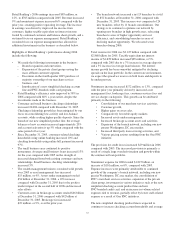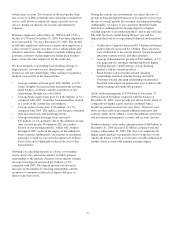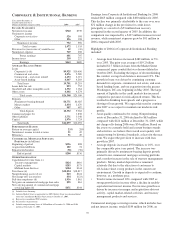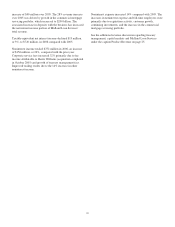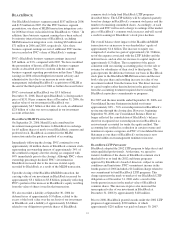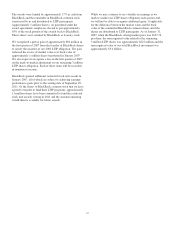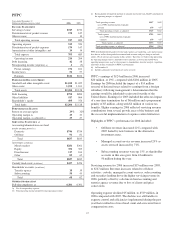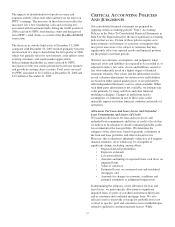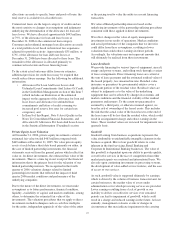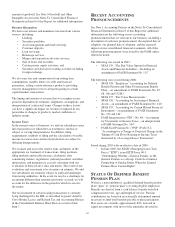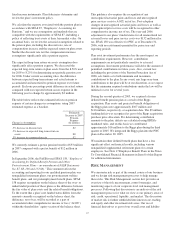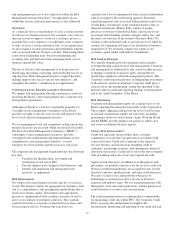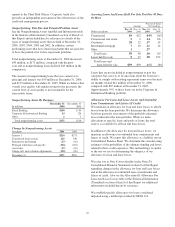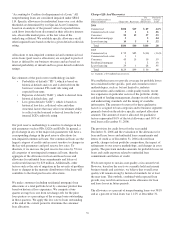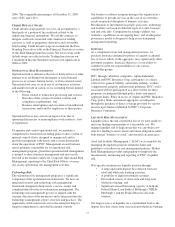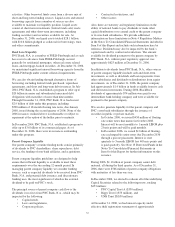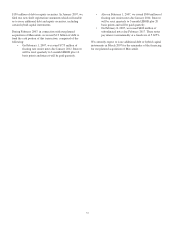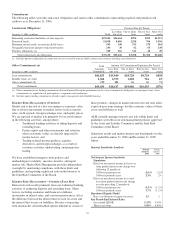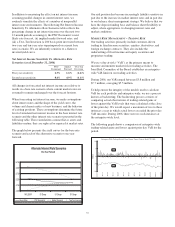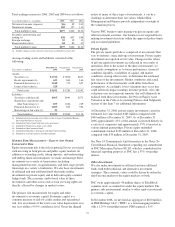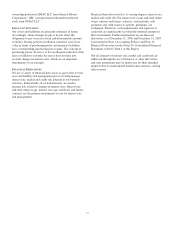PNC Bank 2006 Annual Report Download - page 57
Download and view the complete annual report
Please find page 57 of the 2006 PNC Bank annual report below. You can navigate through the pages in the report by either clicking on the pages listed below, or by using the keyword search tool below to find specific information within the annual report.
fixed income instruments. Plan fiduciaries determine and
review the plan’s investment policy.
We calculate the expense associated with the pension plan in
accordance with SFAS 87, “Employers’ Accounting for
Pensions,” and we use assumptions and methods that are
compatible with the requirements of SFAS 87, including a
policy of reflecting trust assets at their fair market value. On
an annual basis, we review the actuarial assumptions related to
the pension plan, including the discount rate, rate of
compensation increase and the expected return on plan assets.
Neither the discount rate nor the compensation increase
assumptions significantly affect pension expense.
The expected long-term return on assets assumption does
significantly affect pension expense. We decreased the
expected long-term return on plan assets from the 8.50% used
for 2005 to 8.25% for determining net periodic pension cost
for 2006. Under current accounting rules, the difference
between expected long-term returns and actual returns is
accumulated and amortized to pension expense over future
periods. Each one percentage point difference in actual return
compared with our expected return causes expense in the
following year to change by approximately $3 million.
The table below reflects the estimated effects on pension
expense of certain changes in assumptions, using 2007
estimated expense as a baseline.
Change in Assumption
Estimated
Increase to 2007
Pension
Expense
(In millions)
.5% decrease in discount rate $2
.5% decrease in expected long-term return on
assets $8
.5% increase in compensation rate $2
We currently estimate a pretax pension benefit of $33 million
in 2007 compared with a pretax benefit of $12 million in
2006.
In September 2006, the FASB issued SFAS 158, “Employers’
Accounting for Defined Benefit Pension and Other
Postretirement Plans – an amendment of FASB Statements
No. 87, 88, 106 and 132 (R).” This statement affects the
accounting and reporting for our qualified pension plan, our
nonqualified retirement plans, our postretirement welfare
benefit plans, and our postemployment benefit plans. SFAS
158 requires recognition on the balance sheet of the over- or
underfunded position of these plans as the difference between
the fair value of plan assets and the related benefit obligations.
To the extent that a plan’s net funded status differs from the
amounts currently recognized on the balance sheet, the
difference, net of tax, will be recorded as a part of
accumulated other comprehensive income or loss (“AOCI”)
within the shareholders’ equity section of the balance sheet.
This guidance also requires the recognition of any
unrecognized actuarial gains and losses and unrecognized
prior services costs to AOCI, net of tax. Post-adoption
changes in unrecognized actuarial gains and losses as well as
unrecognized prior service costs will be recognized in other
comprehensive income, net of tax. The year-end 2006
adjustment to our plans’ funded status for all unamortized net
actuarial losses and prior service costs was $132 million after
tax. SFAS 158 was effective for PNC as of December 31,
2006, with no restatements permitted for prior year-end
reporting periods.
Plan asset investment performance has the most impact on
contribution requirements. However, contribution
requirements are not particularly sensitive to actuarial
assumptions. Investment performance will drive the amount of
permitted contributions in future years. Also, current law,
including the provisions of the Pension Protection Act of
2006, sets limits as to both minimum and maximum
contributions to the plan. In any event, any large near-term
contributions to the plan will be at our discretion, as we expect
that the minimum required contributions under the law will be
minimal or zero for several years.
During the second quarter of 2005, we acquired a frozen
defined benefit pension plan as a result of the Riggs
acquisition. Plan assets and projected benefit obligations of
the Riggs plan were approximately $107 million and
$116 million, respectively, at acquisition date. The $9 million
funding deficit was recognized as part of the Riggs acquisition
purchase price allocation. For determining contribution
amounts to the plan, deficits are calculated using ERISA-
mandated rules, and on this basis we contributed
approximately $16 million to the Riggs plan during the third
quarter of 2005. We integrated the Riggs plan into the PNC
plan on December 30, 2005.
We maintain other defined benefit plans that have a less
significant effect on financial results, including various
nonqualified supplemental retirement plans for certain
employees. See Note 17 Employee Benefit Plans in the Notes
To Consolidated Financial Statements in Item 8 of this Report
for additional information.
R
ISK
M
ANAGEMENT
We encounter risk as part of the normal course of our business
and we design risk management processes to help manage
these risks. This Risk Management section first provides an
overview of the risk measurement, control strategies, and
monitoring aspects of our corporate-level risk management
processes. Following that discussion is an analysis of the risk
management process for what we view as our primary areas of
risk: credit, operational, liquidity, and market. The discussion
of market risk is further subdivided into interest rate, trading,
and equity and other investment risk areas. Our use of
financial derivatives as part of our overall asset and liability
47


